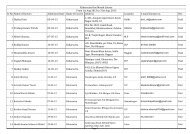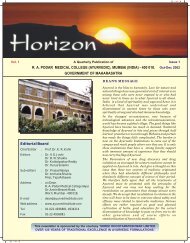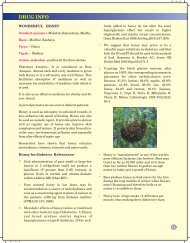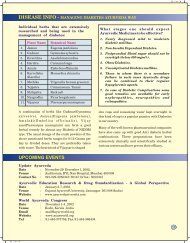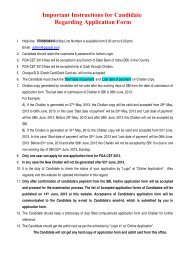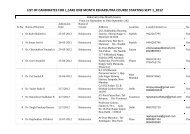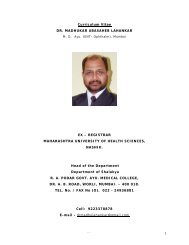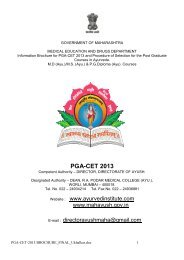Prameha in terms of Diabetes Mellitus, Metabolic syndrome and ...
Prameha in terms of Diabetes Mellitus, Metabolic syndrome and ...
Prameha in terms of Diabetes Mellitus, Metabolic syndrome and ...
- No tags were found...
Create successful ePaper yourself
Turn your PDF publications into a flip-book with our unique Google optimized e-Paper software.
Dosha predom<strong>in</strong>ance KnphnjaBody constitution Obeseaccord<strong>in</strong>gto physiqueEtiology AcquiredStage <strong>of</strong> disease Early/withoutTable 1. Features <strong>of</strong> Prambha Classified on the Basis <strong>of</strong> Prognosisprocess complicationsCl<strong>in</strong>ical Mild hyperglycem<strong>in</strong>manifestations due to disturbedcarbohydrate <strong>and</strong> fattyacid metabolismHyper<strong>in</strong>sut<strong>in</strong>emiaSHARMA AND CHANDOLASadhya YapyaAsadhyaAsadhya(curable) (controllable)tdiffiruh(dificulttomanage)<strong>in</strong> ,@..@..iPittajaAcquiredAcute,youngadultsModemtohyperglycemiaduetohyperadrenalismVatajaAsthenicHereditary(tvpe1diabetes)Acquired(advanced.<strong>in</strong>sul<strong>in</strong>-dependentstage<strong>of</strong>type2diabetes)Chronic/advanced/withcomplicationsSeverehyporglycemmduetohypo<strong>in</strong>sul<strong>in</strong>emiaResearch correlat<strong>in</strong>g diabetes mellitus to conditions with<strong>in</strong> the oral cavity. It lends to adversewith Doshic types <strong>of</strong> <strong>Prameha</strong> changes <strong>in</strong> the gums <strong>and</strong> pcriodontal tissues: effects that may. ... , , , . , bv evident even before cl<strong>in</strong>ical diabetes is recognized <strong>and</strong>A prelim<strong>in</strong>ary studv was conducted to correlate the t<strong>in</strong>- ,. , @ , , , , Vderiv<strong>in</strong>g pathology <strong>of</strong> different stages <strong>of</strong> diabete mdlitus dlaK"^- Conversely penodontal diseases, <strong>in</strong>clud<strong>in</strong>g g<strong>in</strong>will,'the- different Doshic tvpes <strong>of</strong> Prumcha? A small sample 8-.t,s <strong>and</strong> severe penodon,,t,s, can make ,t more difficult to<strong>of</strong> . patients . with .. a compla<strong>in</strong>t . . <strong>of</strong> . diabetes ,.. mellitus ... or previ- . control . , diabetes. I enodontaf disease is associated with*,, . , ,. . r,. . . , ,r, ,. . higher levels <strong>of</strong> <strong>in</strong>sul<strong>in</strong> resistance, <strong>of</strong>ten a precursor <strong>of</strong> type 2ously known to be diabetic was selected. The diagnosis was ... .. . , , . . . . /, ,, y* ,estabhshed @ i- i t <strong>and</strong> j confirmed @@@ j us<strong>in</strong>g @ a glucose i tolerance ltest. diabetes, ,. lt) ' as we .. ,. as with higher h. L eve , s or glyeated hj , hemoe fi o-@. Plasma <strong>in</strong>sul<strong>in</strong>, .. catecholamme, i i @ <strong>and</strong> j cortisol .@ i i levels iwere bm- , Ihese . hnd<strong>in</strong>es ; mav e\, relate , . to , the , prodromal , symptom rmeasured . <strong>in</strong> the . patients. -T-, The i b i ood . sugar i eve i , has i been ' excessive , excretion .. or Malas ,, <strong>in</strong> the buccal cavity. J A sweet, , ,L, \ .. ,, t. , , , taste <strong>in</strong> the mouth is a prodromal symptom that mav becorrelated with plasma <strong>in</strong>sul<strong>in</strong> <strong>and</strong> plasma cortisol levels.. r -.' @S<strong>in</strong>ce _. diabetes ,.. mellitus ... is . a progressive . disease, ,, i_i blood j glu- i expla<strong>in</strong>ed .' by , the presence \. ot glucose ., <strong>in</strong> the saliva. If blood ,cose, plasma.<strong>in</strong>sul<strong>in</strong>,. ..<strong>and</strong>jplasmaIcortisol@ ihaveu ubeen eorreglucose", levels.are high,., - ,.-glucose.isaalso@present, ,<strong>in</strong>@theisaliva,lated with duration <strong>of</strong> illness <strong>and</strong> age <strong>of</strong> the patient. The ', mpatients with features <strong>of</strong> Kiiphnja <strong>Prameha</strong> were identified as , i ' , , . . @ -f . ., ,. , @ /@ (@ @ li j @.@,., A burn<strong>in</strong>g sensation <strong>in</strong> the h<strong>and</strong>s <strong>and</strong> feet is an importanthav<strong>in</strong>g mi d nypertrlycemia (i.e., fast<strong>in</strong>g blood sugar rbS. , . . . ... r @-.@> /j, ^ j l - i- @ t> @ u @ Mature <strong>of</strong> neuropathy that results from diabetes mellitus.up to 140 me/dL), <strong>and</strong> hypennsul<strong>in</strong>emia. Patients hav<strong>in</strong>gr ' @ .f n . , , , . , , @ /,-@> hxcessive sweat as a consequence <strong>of</strong> obesity may result <strong>in</strong>features <strong>of</strong> Pittaia <strong>Prameha</strong> had moderate hyperglyeemia (H3S . . .. .l i .tj uj ^ -c @ > @ t<strong>of</strong>r ,140-2DUmg/dL},., _^, ,,with. ,high, ., catecnolam<strong>in</strong>el . ' @<strong>and</strong>,cortisol@ i bacterial,growth,. ,that.leads.to,.body, J ,odor..Excessive.thirst.., @. h ,' c h ,, .. , may be directly related to disturbed glucose metabolism,levels. These patients were found to be more easily stressed. _, J \ ,. t ._. . , r, , ., . n . @ j -i- j Thus, the symptoms described <strong>in</strong> the Purvurupa <strong>of</strong> <strong>Prameha</strong>Patients with features <strong>of</strong> Vatnia Iramcha were identified as . . . - ,.'.. r ,f, . . , , ' ,rD. nrn . ... , . <strong>in</strong>clude prediabehc symptoms <strong>and</strong> early manifestationhav<strong>in</strong>g severe hyperglycemia rro> 25Umg/uL) <strong>and</strong> hy- ' , . r . ^ .b ^-,->f 6 -: r , , ,. b . . (vascular changes, obesity, etc.) <strong>of</strong> diabetes or subdimcalpo<strong>in</strong>sul<strong>in</strong>enua. lhe results ot this study <strong>in</strong>dicate a correlation ,. "<strong>of</strong> Kiiphaja Pramehn <strong>and</strong> Pittaja <strong>Prameha</strong> with type 2 diabetesmellitus, <strong>and</strong> Vataja <strong>Prameha</strong> with type 1 diabetes mellitus.Sthaulya (obesity) <strong>and</strong> <strong>Prameha</strong>Samprapti (Pathogenesis) <strong>of</strong> <strong>Prameha</strong> The strik<strong>in</strong>g relationship between <strong>Prameha</strong> <strong>and</strong> Sthaulya. (obesity) has been discussed <strong>in</strong> Ayurvedic literature, wherePurvarupa (prodromal symptoms) <strong>of</strong> <strong>Prameha</strong> ,. .- . . , . , ,,, * ,- .@ u -L i aK lK iff <strong>Prameha</strong> n> said to be one <strong>of</strong> the complications <strong>of</strong> obesity. AsIn Ayuroeda, Purvarupa refers to prodromal symptoms1"'-1 >i result <strong>of</strong> physical <strong>in</strong>activity <strong>and</strong> excessive <strong>in</strong>take <strong>of</strong> sweetthat are seen when full manifestation <strong>of</strong> the disease has not substances, there is formation <strong>of</strong> Ania, which is a buildup <strong>of</strong>yet taken place. For Pramehn, these symptoms <strong>in</strong>clude ex- tox<strong>in</strong>s from improperly digested food <strong>and</strong> metabolic prodcessivesweat, body odor, laz<strong>in</strong>ess, <strong>in</strong>cl<strong>in</strong>ation towards rest, ucts. The buildup <strong>of</strong> Ama leads to additional formation <strong>of</strong>presence <strong>of</strong> excessive Ma<strong>in</strong>s (waste products) <strong>in</strong> the eyes, Meda (fat). This refers to an <strong>in</strong>crease <strong>in</strong> adipose tissue <strong>in</strong> theears, teeth, throat, palate, <strong>and</strong> tongue (buccil cavity), execs- body, result<strong>in</strong>g <strong>in</strong> the <strong>in</strong>dividual becom<strong>in</strong>g overweight. Itsive growth uf hair <strong>and</strong> nails, matt<strong>in</strong>g <strong>of</strong> the hair, excessive reflects the current underst<strong>and</strong><strong>in</strong>g <strong>of</strong> the peculiar metabolicthirst, a sweet taste <strong>in</strong> the mouth, a burn<strong>in</strong>g sensation <strong>in</strong> the state <strong>in</strong> obese <strong>in</strong>dividuals, where<strong>in</strong> carbohydrate is largelyh<strong>and</strong>s <strong>and</strong> feet, attraction <strong>of</strong> <strong>in</strong>sects <strong>and</strong> ants toward the converted to fatty acids. The multifactorial <strong>in</strong>volvement <strong>of</strong>body <strong>and</strong> ur<strong>in</strong>e, <strong>and</strong> so on. <strong>Diabetes</strong> has a close relationship Mi'da (fat), Kapha, Vata. <strong>and</strong> Agni (digestive metabolic activ-



